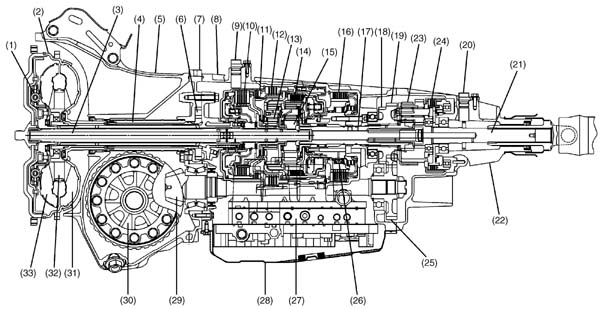The center differential in a typical Subaru transmission is housed inside of the main transmission case. For the MT models, these are typically viscous-coupling that control the torque split between the front and rear differentials (which may be open, viscous/clutch/Torsen LSD, etc.). The AT models may have different things that function as a center differential that I'm not as familiar with.
Some overview on the different AWD systems Subaru has:
Center Differential with Viscous LSD
In this AWD system, the center differential is implemented by a
bevel-gear, utilizing a mechanical viscous coupling device acting as
limited slip function. This type of differential is commonly known as
VLSD (Viscous Limited Slip Differential).

In the above diagram, (10) is the center differential, and (11) are the viscous coupling plates.
Active Torque Split + Multi-Plate Transfer Clutch
This is the most common type of AWD in the market. In this system, a
multi-plate clutch pack acts as power coupling, and is responsible for
transfering power to the front wheels. The ECU uses multiple sensors’
input to determine the optimal torque split ratio, then it controls
the hydraulic lines to apply suitable pressure between the input and
output clutches, therefore achieving the goal of actively adjusting
front/rear torque distribution ratio.

Variable Torque Distribution (VTD)
For this AWD system, Subaru installs a planetary gear-set as the
center differential, and uses a multi-plate clutch to implement the
limit slip functionality.
This system is fundamentally different than the above #2 type. For the
VTD system, the power transmitted to front wheels is passed through
the planetary gear-set, not the clutch pack. The multi-plate clutch
only acts as limit-slip protection, and it will not kick in unless
wheel slip is happening.

In the above picture, (23) is the planetary gear differential, and (24) is the electronically controlled clutch-pack.
Driver Controlled Center Differential (DCCD)
The DCCD AWD system is specifically for the WRX STI (6MT). In fact it
is the VTD, plus an extra feature to let driver manually select
front/rear torque distribution, and both of the front/rear
differential are also LSD type. Default front/rear torque distribution
is 41:59; maximum adjustment ability is 50:50.

The above picture depicts the two LSDs used in the DCCD. The electrical LSD allows the driver to adjust the torque bias between the front and rear in real-time. Here's an official document from Subaru explaining the DCCD system in detail (ca. 2016).
Source




